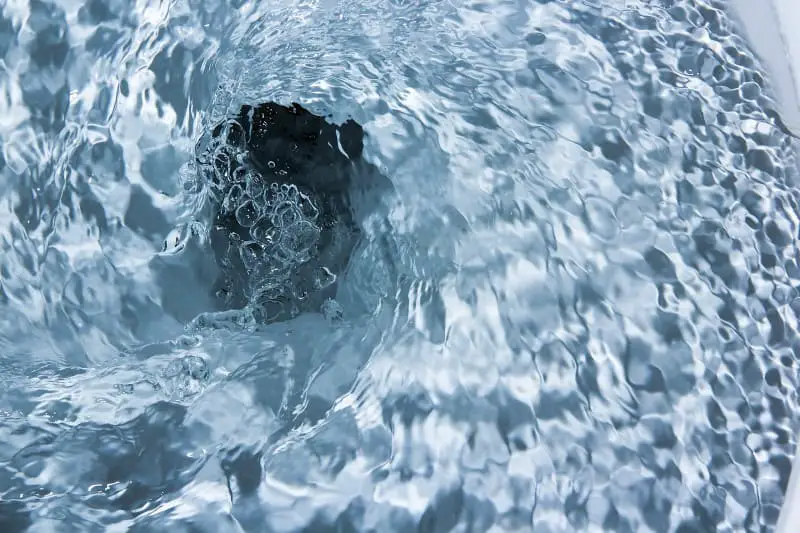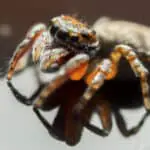Desperate times call for desperate measures. If an animal finds itself in unfamiliar territory, it has to quickly develop a way to survive despite how harsh the situation is. Spiders, for instance, have always shown that they can easily adapt to new environments, even survive extreme temperatures and food scarcity.
Spiders cannot drown easily. It would take a lot of time, strong currents, and hours without an oxygen supply to drown a spider. If the water is calm, they can float due to their lightweight and paddle the water as they push forward.
Let’s have a closer look at the spider’s swimming skills to find out whether it can easily drown. We will consider various species to give a better perspective. Read on for mind-blowing facts.

Are Spiders Great Swimmers?
Spiders are famous for their adaptability even when they find themselves in harsh conditions because they will do anything possible to survive. It has contributed to their living over millions of years without facing extinction. Although they lack fins or any other feature that help aquatic creatures float or tread through waters, they can somehow swim.
A spider’s swimming prowess depends on the individual, its species, and its size. However, they only swim out of necessity and when it is their only way to survive. They would do anything even if it means swimming as the last option.
Experts state that some spiders have developed the unique skill to navigate large water bodies while others can breathe while underwater. Unlike other water creatures that move their fins and tails when in water, spiders take advantage of being lightweight and their many limbs to help them maneuver along water surfaces and even survive mild currents.
The primary spiders’ advantage is that they can float. Secondly, they can paddle their legs fast and distribute their weight in the process to stay afloat. Spiders’ bodies are not designed for swimming. Therefore, they have to use any necessary means to avoid submerging and drowning.
If the waters are troubled, they can hold on to floating objects to survive. When they get too tired to paddle or propel themselves, they will rely on plants or other objects around to stay afloat. If the water is still, it will be easier for them to cross narrow water bodies. They will only find it tasking if there are strong waves and the water body is too large.
The Best Spider Swimmers
Tarantulas fall under the category of incredible arachnids that can swim. They are giant spiders and find it easier to stay on the water surface. They use the same principle as ships when on the water surface.
Tarantulas displace a large water volume since they are huge, and, in turn, exert less pressure enabling them to tread softly and cross water bodies. Like any other spider or land animal, tarantulas would rather not swim if they have a choice. They only get into the water when they have to. They may only do it to evade predatory attacks or when chasing their prey. Similarly, they choose to swim if there is a large water body in their path and have to get to the other side.
Male tarantulas are more likely to swim in their quest for a mate. They are known to travel great distances and face many challenges in the process. Thus, even pools of water cannot stand in their way.
Apart from tarantulas, there are other avid swimmers in the spider kingdom called dolomedes, or the diving spiders. Unlike other arachnids, they are surprisingly great swimmers, able to dive, survive underwater, and even feed on small fish species. Most of these spiders live in the northern part of America.
The fascinating thing about them is that they spend the largest part of their lives in water and have incredible paddle ways as they swim. Using their limbs, they vigorously hit the surface as they spread out their limbs.
One spider from the dolomedes family known to be an incredible swimmer is the Brisbane species. It spends most of its life in and around water bodies and is best adapted for swimming. Even with their huge bodies, these spiders can still dive skillfully and attack tiny water creatures. They are one of the most feared hunters in the sea world, although their counterparts are primarily land animals.
Lastly, the best swimmer is the diving bell, which is mostly found in Europe. They are such great swimmers that they are referred to as aquatic insects, and you are likely to find them in large freshwater bodies. Their meals consist of miniature insects and fish, and they are famous for being great divers and hunters.
The diving bells are by far the most adept at swimming, with the ability to dive into the water and remain submerged for a long time. They stay underwater and only emerge when they need to replenish their air supply. The spiders trap air pockets within their hairs and use them as an additional oxygen source when they are underwater for too long.
Can Spiders Live Underwater?
Animals living underwater are specially designed to adapt to the aquatic environment. For instance, fish have gills while turtles can hold their breaths for a long time. So, what is the case of the spider?
Most spiders cannot survive while submerged. However, certain species like the water spider/ diving bell spend their entire life in water just like any other aquatic animal and only resurfaces for air replenishing. This spider species colonizes most freshwater bodies with vegetation like lakes, ponds, and streams. They rely on aquatic insects like mosquitoes and other tiny creatures to survive.
Thanks to certain features, the spiders can maneuver underwater. They are hairy and can create silky webs. These hairs repel water and enable the spider to trap air which is critical when they are underwater.
Consequently, gaseous exchange occurs through the abdomen spiracles. Remember that spiders don’t have gills and only use the air balls like false gills necessary for breathing. However, they entirely rely on spiracles to supply their systems with the air from their reservoirs. Researchers found out that the silk web can extract oxygen from the surrounding water when the oxygen level is low. If the web collapses, the spider will have to travel up the water surface for replenishment.
Can Spiders drown?
Spiders are known to be land animals, but some species can live and thrive even underwater, as we have noticed. The only concern is the remaining percentage. So, will they survive even when submerged?
Spiders can drown, but it depends on the individual and its species. Some species like the dolomedes use air bubbles to help them breathe while underwater; hence, it is tasking, if not impossible, to drown them.
On the other hand, common house spiders or other species adapted to land will have to put up a fight to survive. Unfortunately, they are not great swimmers and will struggle to stay alive when the currents are too strong, or the spider is too tired to keep propelling itself across the surface. In dire and extreme cases, the spider will eventually lose oxygen supply and drown.
Spiders would rather not swim because it is tasking, and they risk drowning. Therefore, if the waters are too rough, say you flush them down; they will struggle not to drown, particularly if you wash them down into a sewer. Such places are oxygen-deprived, and the spider would likely die from suffocation.
The good thing is, in dire situations, the spiders can lower their metabolism and survive for up to an hour before oxygen replenishment. Therefore, if the spider can quickly adapt, it would be difficult for it to drown. In isolated cases, some can stay for as long as three hours without oxygen.
It may take a while for an aquatic spider like the Brisbane or diving bell to drown completely. They will have depleted their oxygen supply from the trapped air for them to die due to suffocation. The diving bell can stay for a whooping twenty-four hours while submerged. They utilize their webs and water bubbles as an alternative air source. Thus, it would take a while for you to drown aquatic spiders completely. The surest way that spiders can drown is by flushing into a sewer without an adequate oxygen supply.
Wrap Up
Spiders are not avid swimmers, and it’s only a few lucky ones that can maneuver underwater or even survive while submerged. However, it is very difficult for the aquatic spiders to drown underwater, and some can go for an entire day underwater. Other land spiders are not gifted in swimming, but they can devise ways to navigate the water and even hold their breaths for long.
Spiders are lightweight; hence, able to stay afloat and paddle their limbs fast to help them move. Therefore, it is tasking to drown a spider. Even when the currents are strong, they will fight to survive and only lose the battle after getting tired of trying to swim and when they have lost all their air reserves.
Read more: Do Spiders Drink Water








